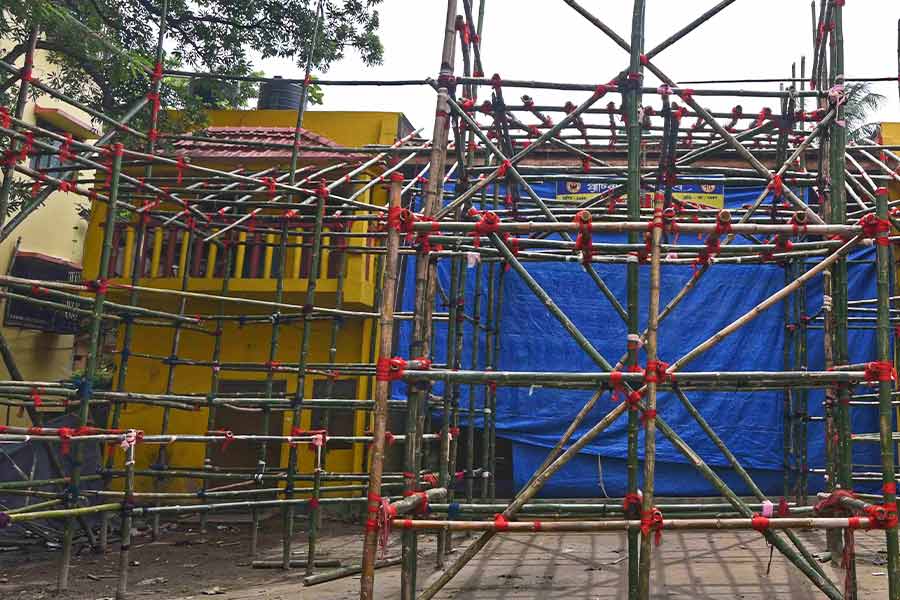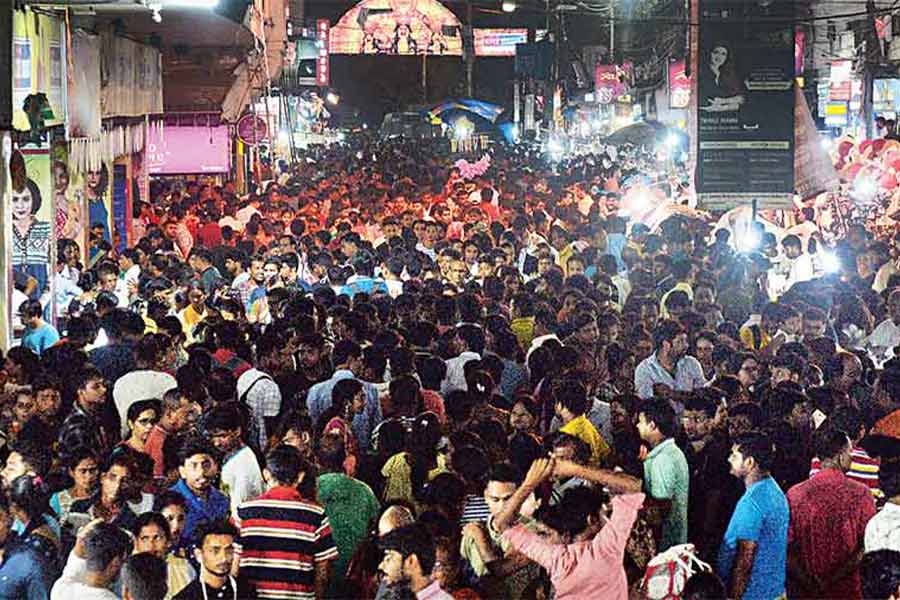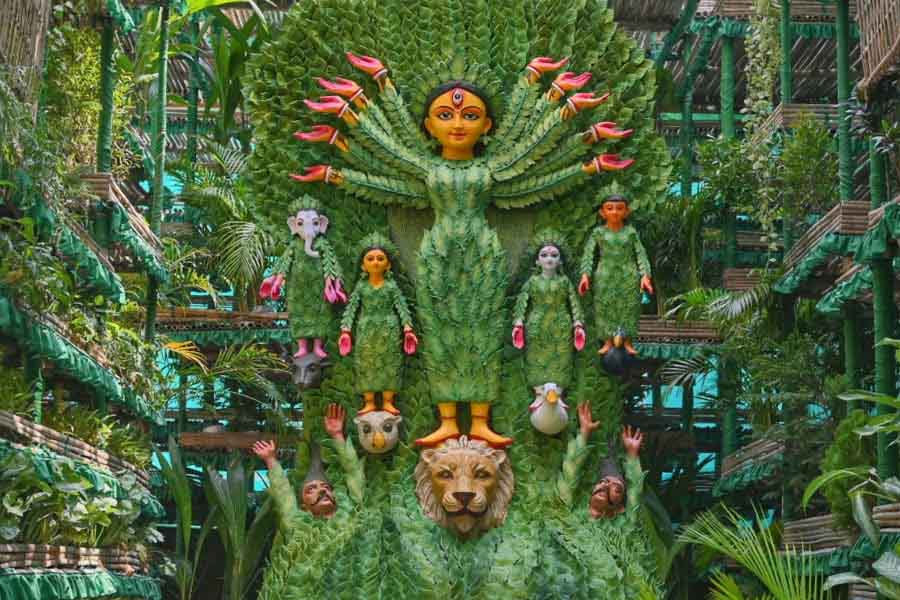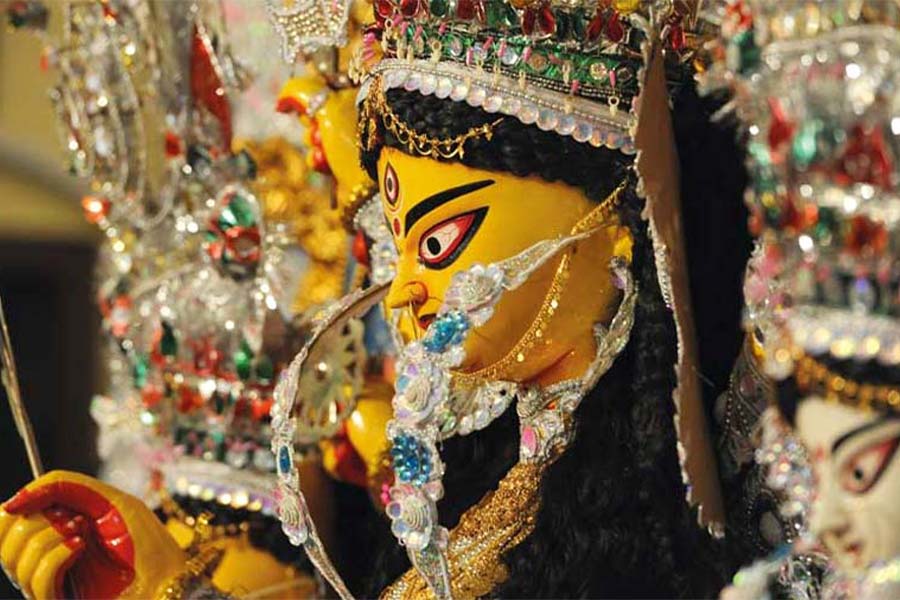Potla is the president of a popular, 80-year-old barowari puja, with one eye on TV cameras and the other on the seat of a ward councillor. He sits in sukhasana, on a gaddi vacated by the patriarch, Shri Radheramji Bajoria, two Pujas ago and winks at the reporter of a prominent Bengali news channel, looking for his elusive byte. Durga Puja is not far away; in fact, another month and dhakis will throng the Sealdah station. Potla tucks in his potbelly and quickly wears a jibonmukhi-singer look when the reporter asks him to explain the theme of the Puja. “It showcases our state’s commitment to nari suraksha,” he mutters; his pursed lips hiding gutkha-rinsed teeth.
To capture the gaddi of Shri Bajoria, Potla did have to mount a coup. Although it was bloodless, it was still loaded with red gutkha spit. After the patriarch died of pneumonia, his grandson tried to take up the thick, white seat with two sausage-shaped pillows, but his efforts were thwarted by Potla’s kochikacha gang, or the gang of Lil’ Ones. As Shri Bajoria’s grandson stepped out of his 4x4 SUV, the Lil’ Ones, on their 200cc bikes, surrounded the hapless heir. Soon, the choicest north Kolkata cuss words were exchanged, and gutkha-red spittle dropped like incessant August rain. The verbal skirmish ended Bajoria family’s stranglehold on the Puja committee and paved the way for Potla’s political ambitions.

Well dug by bamboo scaffoldings, the grounds of barowari pujas have always been fertile for political dreams to germinate TT Archives
Well dug by bamboo scaffoldings, the grounds of barowari pujas have always been fertile for political dreams to germinate. Over the years, many Pujas have lost their primary names like Roynagar Friends Union or Hedua Cultural Centre, and they are now known as Soumen-da-r puja or Keshto-da-r puja — after politicians with deep pockets and even deeper connections. Potla eagerly waits for the day when his puja will be called Potla-da-r puja.
He knows it won’t be easy, but he has full faith in Shib Narayan Banerjee. The head priest of the puja is famous for making Ma Durga jagroto, and in her fully awakened state, the mother is known to fulfil the wishes of her children. Not all children though, only those who can open their wallets to Shib Narayan. Because of Shibu-da’s mantras, Ma’s generosity made the Bajorias richer by the day. Potla plans to divert some of the sponsorship money to make Shibu-da wriggle out copious blessings from Ma Durga for him.
Mela, khela and chela

Mela, khela and chela (sports, carnivals and lackeys) — the three pillars of political success
Potla also vouches for the three pillars of political success, as championed by the Supreme Leader himself — mela, khela and chela (sports, carnivals and lackeys). Bajoria Jr got the foul taste of Potla’s chelas, Lil’ Ones. Melas like pakhi, phool, and kukur are lined up to last the full festive season. Potla, being a ghoti and a Mohun Bagan fan, plans to get the leading stars of the club for a five-a-side tournament. But just like golda chingri remains the best part of a Bengali wedding buffet, Durga Puja persists as a top draw on the committee’s annual calendar. It is this event that Potla desperately wants to make his own because he knows that a successful puja is a shortcut to a councillor’s chair.
Inside the committee office, a couple of LED-lit dewal almaris hold ‘Best Puja’ awards won by the puja over the years. Potla, renouncing the joy of sukhasana, sits in a plastic chair. Swaying his legs like elephant ears and munching telebhaja, he indulges in some light-hearted banter with the girlfriends of the Lil’ Ones. The girls are all vloggers; they run channels on cooking, make-up and street food. Potla knows how to harness them. He understands that a good social media campaign can draw crowds, and he needs serpentine queues of lakhs each day to make the advertisers and sponsors happy. Of course, a swelling crowd also puts pressure on the brands to hand over ‘Best Puja’ awards — more people, more awards, more advertisers, and more money. “Bolo Durga Ma ki jai!”

A shot of the priest’s dhuno-induced teary eyes while chanting mantras — an essential part of a social media blitzkrieg list
The puja committee thinks that the ‘nari suraksha’ theme will resonate well with the masses, and Potla is certain that it will show him in a good light before his future voters. One Sunday morning, Potla convenes a meeting to discuss what he calls ‘Duare Jono Jowar’ or ‘A Sea of People at our Doorstep’ — a winsome plan to win hearts, awards, sponsorships and a councillor election ticket. Papia who runs a street-food channel ‘Raastar Rannaghar’ is unanimously elected as the content strategist. Potla, like a digital marketing guru, speaks of engagement through soppy online videos. He asks Papia to surely include reels by influencers like Nyaka-di and Viral-da. Drone shots of the pandal, Shibu-da’s dhuno-induced teary eyes while chanting mantras, and tragic backstories of the theme artist and the idol maker were quickly added to the 10-day social media blitzkrieg list.
Of queues, celebrities and captive constituents
The blueprint of ‘Duare Jono Jowar’, of course, didn’t end with the social media strategy. Potla, hailed by many as Chanakya, is never short of masterstrokes. On the whiteboard, in one sweep, he jots down the to-do list like a grey-haired UPSC tutorial teacher. Putting up bamboo barricades to narrow down lanes for pandal-hoppers appears at the top of the list. The logic is simple — allow fewer people to enter the mandap, create a few-kilometre-long queue, and create an impression that everyone is falling over themselves to see the puja. “It’s all about perception,” Potla enounces with confidence.

Creating an impression that everyone is falling over themselves to see the puja is important
A container-truck-long stage on the main road, next to the tramlines, is also planned. Various MPs, MLAs, film stars and even the daughter of the Chief Ruler are expected to visit the puja. A big stage will give a widescreen-TV effect, on which Potla, and only he, will be sharing the limelight with celebrities, felicitating them, and of course, pitching to the parabashis his potential to be their next municipal councillor.
Today is Tritiya, in a few more days the city will come alive: crow-nest grey beards with be cleaned, new butter-paper-wrapped saris shall come out of creaky almirahs, fast-fashion clothes will run riot, raastar rannaghars will become insomniacs, and kids will stay mesmerised by asura’s dreadlocks and the lion’s snarl. Potla sits next to Ira-di who is silently watching Ma’s face before harsh lights turn her into a backdrop for selfies. With her son in Seattle, Ira-di lives alone. Potla often drops in on the elderly like her. He sees them as captive constituents.
“Kemon lagchhe?” (How does Ma look?) asks Potla. Ira-di, still in a hypnotic state, doesn’t care to respond. Potla doesn’t press on; he lets out a deep philosophical sigh and looks at Ma’s calm face. He thinks about the impermanence of life. In the same way he wants to take the sitting councillor’s place, one of the Lil’ Ones will also become impatient to dislodge him some day. And the game will continue. The only thing that will remain permanent is Durga Puja. The thought makes him smile. He closes his eyes and asks the goddess to give people the courage to fight injustice, make children living around the world return home to their elderly parents, to usher in happiness and equality, and, of course, to make him the next councillor.
(Disclaimer: This is a work of fiction)
Kundan Chakrabarty uses words to sell soaps, pens and zany stories. Reach out to him at kundan.chakrabarty@gmail.com


